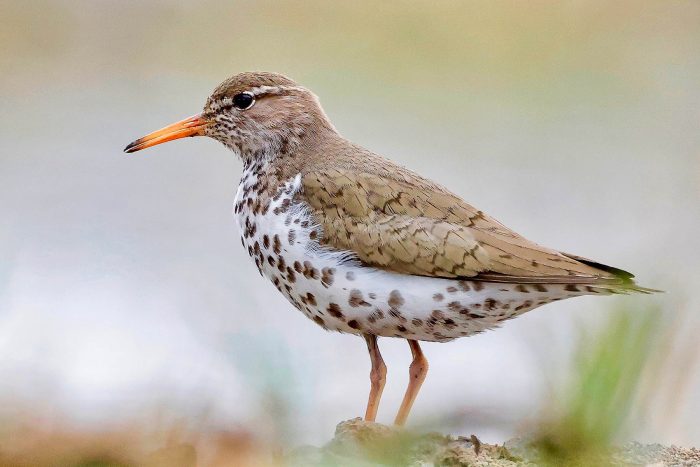Spotted Sandpiper
Actitis macularius
The spotted sandpiper is a medium-sized shorebird that can be found throughout the Chesapeake region during the summer.
This section shows one large critter image at a time. Use the thumbnails that follow to select a specific image to display here.

This gallery contains a grid of small thumbnails. Selecting a thumbnail will change the main image in the preceding section.
Appearance
Spotted sandpipers get their name from the dark spots that appear on their white breast during the breeding season. Their back is dark brown, and during the winter, their breast is plain white. When flying, spotted sandpipers have a thin white stripe that appears along their wings.
Feeding
The diet of spotted sandpipers includes almost anything that is small enough for them to eat. Common foods include midges, mayflies, flies, grasshoppers, crickets, worms, snails and small crustaceans. Spotted sandpipers are foragers; they’ll poke into sand or mud with their bills, lunge at moving prey, catch flying insects or pick bugs off of plants.
Predators
Common predators of spotted sandpipers are mink, weasels and a variety of raptors. Deer mice, blackbirds and song sparrows will eat spotted sandpiper eggs, while grackles, crows and gulls will eat their chicks.
Voice
A clear peet-weet; also a soft trill.
Reproduction and life cycle
Spotted sandpipers breed between May and August. Females arrive to the breeding grounds earlier to establish and defend territory. They will sometimes also mate with multiple males, with each male caring for the clutch of eggs. Females generally lay a clutch of four eggs, and they can lay up to five clutches a year.
These birds are unusual in that the males provide the majority of parental care. Chicks are able to walk within four hours of hatching, and can feed themselves shortly after.
Did you know?
- These birds make a teetering motion, although researchers are not quite sure what function it serves. The motion gets faster when the bird is nervous, but it stops when the bird is alarmed, aggressive or courting. Chicks teeter shortly after hatching.
- The spotted sandpiper's characteristic teetering motion had earned the bird a variety of nicknames, including teeter-peep, teeter-bob, jerk or perk bird, teeter-snipe and tip tail.
- The oldest recorded spotted sandpiper was 12 years old.
Sources and additional information
- All About Birds – Cornell Lab of Ornithology
- Animal Diversity Web – University of Michigan Museum of Zoology
- Guide to North American Birds – Audubon
